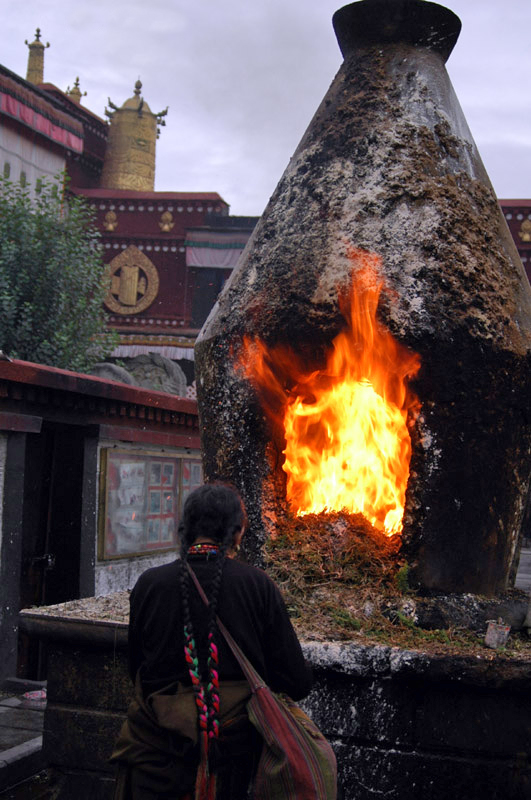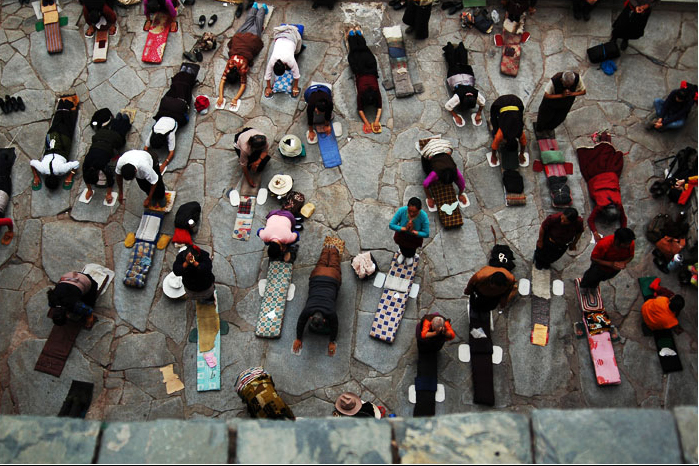
As the spiritual heart of Lhasa and the holiest house of worship in Tibet, the Jokhang Temple is unceasingly buffeted by waves of pilgrims eager to prostrate themselves in its courtyards, spin its prayer wheels, and chant within its venerable halls. Although it is technically maintained by the Gelugpa or Yellow Hat sect, it currently accepts worshippers from all branches of Buddhism. Its undeniable historical significance and continuing cultural importance to the region meant it was designated a UNESCO World Heritage Site in 2000, alongside the nearby Potala Palace and the Norbulingka. With its intricate mixture of Indian, Tibetan, and Nepalese features, it is an architectural gem beyond compare.
The temple was originally built in 652 by Songtsän Gampo, founder of the Tibetan Empire (618–842). However, the nature of its construction is shrouded in mystery. Countless legends surround the sacred site, the most prevalent of which is that, in ancient times, the Tibetan people believed that Tibet rested on the back of a wild demoness known as a srin ma. Whenever the King tried to build the temple, it would miraculously collapse overnight and they’d have to begin construction again. It was apparently the King’s second wife, Princess Wencheng of the Han Chinese Tang Dynasty (618-907), who discovered that it was in fact the demoness thwarting their attempts to propagate Buddhism throughout the region.
In order to halt her evil schemes, the King was required to build twelve temples: four on the frontiers, four in the outer areas, and four in central Tibet. Finally, the last temple had to be built over the site of a lake, which was said to be the demoness’ heart. Using 1,000 goats to carry soil from nearby mountains, the lake was filled and the Jokhang Temple was built in its place, subjugating the demoness once and for all. Another legend recounts how the King reputedly tossed his ring and promised to build a temple wherever it landed. It landed in a lake and, like the mighty Excalibur, a white stupa[1] emerged from beneath the crystal clear waters, over which the temple was built.
A far more likely explanation is that the temple was built to house the statue of Akshobhya[2] Buddha which the King’s first wife, Princess Bhrikuti of the Nepalese Licchavi Kingdom (c. 400–750 AD), brought with her as part of her dowry. Not to be outdone, Princess Wencheng presented the King with a far more valuable gift, one that is still revered as the holiest idol in Tibet. It was a statue of Shakyamuni[3] Buddha, but not just any statue. This statue, known as the Jowo Shakyamuni or the Jowo Rinpoche, was supposedly carved at the behest of the Buddha himself, and is one of only three such statues that the historical Buddha permitted to have made during his lifetime.

This life-sized 1.5-metre (5 ft.) tall statue depicts the Buddha at age 12 and was gifted by the King of Magadha (modern-day Bihar and Bengal, India) to Emperor Taizong of the Tang Dynasty before being used as Princess Wencheng’s dowry in 641. Glittering in the light, it is cast from precious metals and bedecked with a constellation of jewels. The statue was originally housed in the Ramoche Temple, but was moved to the Jokhang Temple on the death of Songtsän Gampo for security reasons. In fact, the Jokhang Temple was initially known as the Tsuklakang or “House of Religious Science”, but was renamed the Jokhang or “Temple of the Jowo” in honour of this statue!
From 756 to 797, during the reign of Trisong Detsän, the King’s minister became particularly hostile towards the spread of Buddhism in Tibet, so the statue had to be hidden. When the 5th Dalai Lama, Ngawang Lobsang Gyatso, unified Tibet and became its independent leader during the 17th century, the temple and Lhasa as a whole enjoyed a golden era of spirituality. Although the temple was expanded greatly during this time, much of the original 7th century structure has been remarkably well-preserved.
The temple itself is a four-storey timber structure with a distinctive golden top. From the main square, one can view the entire complex. There are two steles[1] in the square, one recording an alliance between the King of Tibet and the Emperor of the Tang Dynasty, and the other engraved with hygiene tips on how to prevent the spread of smallpox. Even in ancient times, the government had a way to issue health and safety warnings! In the eastern section of the complex, a row of votive lights form a dimly lit path leading to the main hall.
At over 1,300 years of age, the Buddha Hall is the oldest building in the complex. It is where the sacred Jowo Shakyamuni statue is currently housed, and also contains magnificent gilded statues of Songtsän Gampo, Princess Bhrikuti, and Princess Wencheng. A number of chapels surround the main hall, all dedicated to various deities and bodhisattvas[5] in the Buddhist canon. Thick with the smell of incense and illuminated only by flickering candles, a labyrinth of secluded corridors are the only paths connecting the halls and chapels of the complex. Outside, the doors and roofs are bedecked with glorious golden engravings, from docile deer flanking the Dharma wheel to monstrous dragons guarding the eaves.
When it comes to worship, there are three pilgrimage circuits in Lhasa: the Lingkhor, which encircles the city’s sacred district; the Barkhor, which circumvents the Jokhang Temple; and the Nangkor, a ritual corridor within the Jokhang Temple that surrounds the statue of Jowo Shakyamuni. Every day, hundreds of pilgrims perform a kora[6] around each of these three circuits while prostrating themselves, chanting sacred mantras, or spinning prayer wheels. For this reason, the temple is closed to tourists in the morning and reserved solely for pilgrims. While the temple’s historic importance is part of its allure, witnessing the devotion that the locals continue to have for their faith is the real key to the Jokhang Temple’s magic.
Notes:
[1] Stupa: A hemispherical structure with a small interior designed for storing Buddhist relics and for private meditation.
[2] Akshobhya: According to Buddhist scripture, Akshobhya is one of the Five Wisdom Buddhas and represents consciousness as an aspect of reality. He is the embodiment of “mirror knowledge”, which states that the mind should be like a mirror: empty yet luminous, holding all the images of space and time yet untouched by them.
[3] Shakyamuni: One of the titles of Gautama Buddha, the central figure and founder of the Buddhist faith. It is derived from the place named Sakya, which is where he was born.
[4] Stele: An upright stone slab or pillar that bears an inscription and usually marks a burial site, like a tombstone.
[5] Bodhisattva: The term literally means “one whose goal is awakening”. It refers to a person who seeks enlightenment and is thus on the path to becoming a Buddha. It can be applied to anyone, from a newly inducted Buddhist to a veteran or “celestial” bodhisattva who has achieved supernatural powers through their training.
[6] Kora: A kora is both a type of pilgrimage and a meditative practice in Tibetan Buddhism. The practitioner performs a kora by making a clockwise circumambulation around a sacred site or object, typically as part of a pilgrimage, ceremony, celebration, or ritual. In some instances, it is used as a broader term to describe the entire pilgrimage experience.
Make your dream trip to the Jokhang Temple come true on our travel: Explore Untouched Wilderness on Our Full Circuit of Tibet